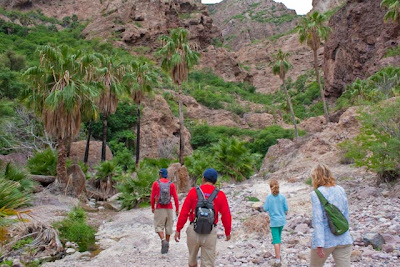 In the language of the Yaqui people nacapule (pronounced knock-ah-poo-lay) means earlobe. It’s also the name given to a rare fig tree that has generous knees like a Cypress tree and to a canyon that I read about in a tourist brochure.
In the language of the Yaqui people nacapule (pronounced knock-ah-poo-lay) means earlobe. It’s also the name given to a rare fig tree that has generous knees like a Cypress tree and to a canyon that I read about in a tourist brochure.Places that we read about in tourist brochures are often out of reach for us—for two reasons: they are either too far to get to by foot, or bus, from our boat, or they cost too much for our non-tourist budget. Then there is the fact that wild places that are populated by tourists sometimes have the magic scrubbed out of them—they’ve been made so accessible that the essence that made them captivating is gone.
But because I’m doing a story on San Carlos and need to see the things that tourists see I pay attention to the tourist brochure. And this morning we found ourselves following roads north out of San Carlos. Our guides Fernando and Miguel drive us through the suburbs, then across an arroyo and through familiar desert. Ahead of us is the Sierra Aguaje Mountain range, a string of rugged volcanic formations, where black, red, and rust-hued strata fold over each other in graceful tucks and pleats.
As we grow closer to the mountains our destination becomes clear: a deep ocher-coloured cleft carved into the cliffs. We park and Fernando leads us along the trail to the canyon, pointing out ironwood and jasmine, chichinoco squirrels and swallowtail butterflies. Miguel explains how rare and fragile the sub-tropical ecosystem of the canyon is as he leads us deeper into the desert oasis.
Along the way we pass a bit of graffiti and a few burned palms and Miguel explains that locals are only beginning to have reverence for the canyon. He explains that for the Yaqui people the canyon was sacred—that between the year-round springs-for water, plentiful wildlife-for food, large trees and obsidian rock-for tools, the ancient people found all they needed here.
We continue to make our way up the canyon, following a trickle which gives way to deep tea-coloured pools filled with rare frogs and swimming snakes. The air (which can be unbearably humid in the summer) is comfortable and cool. We scramble over blood-red rocks, through palmetto thickets and up a small cliff—until we find ourselves in the heart of the canyon where the graceful Nacapule fig grows, its bark wrinkled like elephant's but silky to the touch.
It’s hard not to fall in love with a place like this—a place so mystically beautiful I want to keep going long after the trail turns more rugged than we’re comfortable with. So we sit for a while and soak it all in. Then we head back down the trail, leaving nothing behind and collecting the small bits of garbage along the way so the next hikers might understand that this a cared-for canyon, a sacred place that can provide us with everything we truly need to thrive.






No comments:
Post a Comment